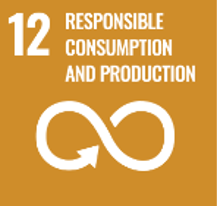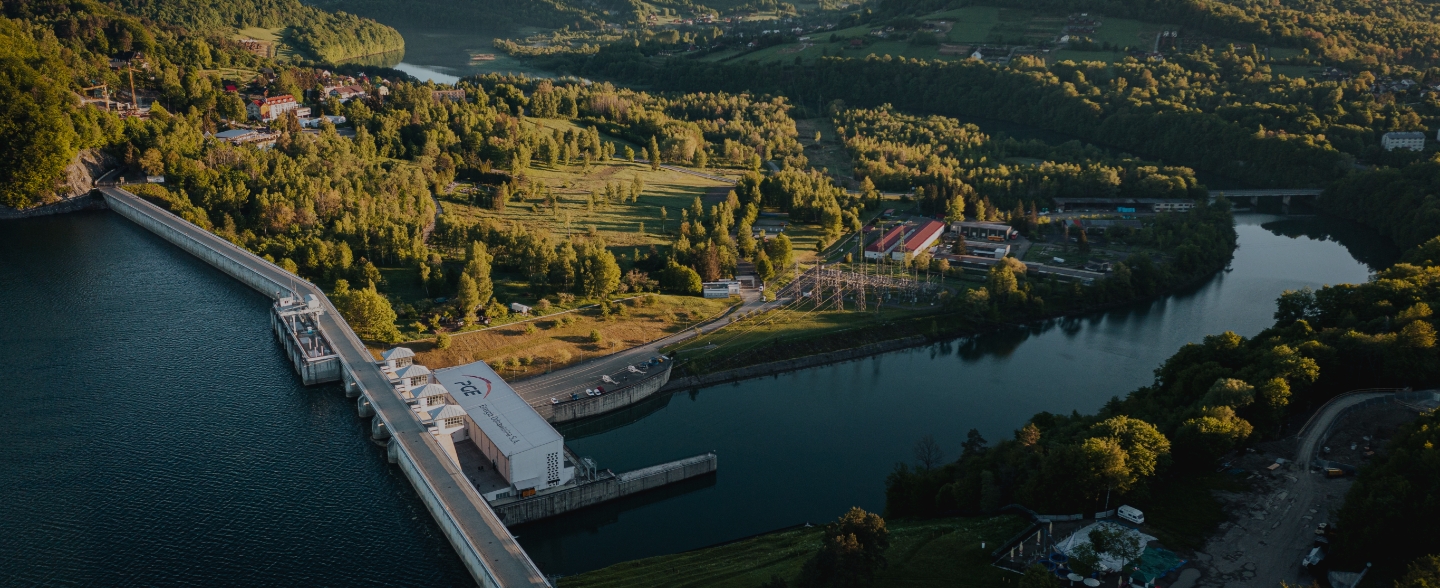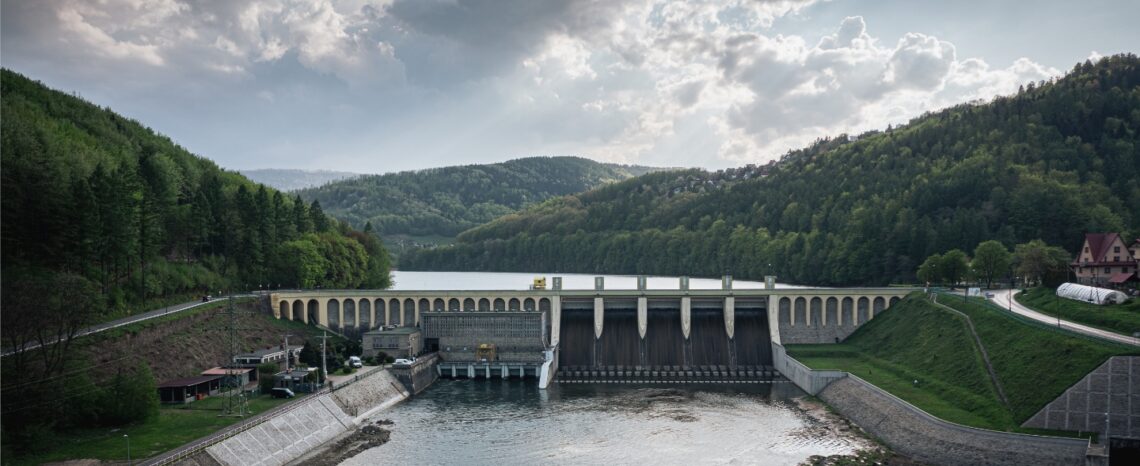-
303-1
-
303-2
-
306-1
-
103 (303)
Water is fundamental to our business. We use it both in generation from conventional sources and in hydroelectric power plants. On-going attention to the quality of this resource is our responsibility.
PGE Group monitors the quantity and quality of water abstracted and wastewater discharged in accordance with administrative decisions issued in this respect. Processes related to water and sewage management at PGE Group’s sites are carried out mainly on the basis of the Water Law and other executive acts dedicated to water and sewage management. They are carried out in accordance with administrative decisions issued by competent authorities, such as integrated permits or sectoral decisions (water-law permits).
Transparency of water resource disclosures
In the survey, PGE reported a wide range of data in the area of water management, especially in relation to electricity and heat production and lignite mining. The data disclosed includes, among other things, the individual levels of water treatment in the operations, including technical information on the level applied for discharged water. Detailed data on water abstractions and wastewater discharges for individual installations are compared on a year-on-year basis. Water management information provided by the CDP study is available by logging on to the platform at cdp.net.
-
303-5
| 2021 | Volume (megaliters/year) |
|---|---|
| Total withdrawals | 28,230,728.29 |
| Total discharges | 28,123,422.88 |
| Total consumption | 141,061.96 |
Water management in the mining process
Lignite deposit exploitation using the open-pit method, carried out at the Bełchatów and Turów lignite mines, requires prior dewatering of the rock mass, which has a significant impact on hydrogeological conditions and results in changes in hydrodynamic relations. Water management in lignite mines is connected with both deep dewatering and surface dewatering of open pits. Water from the pits is discharged to field settling ponds for final purification by natural sedimentation of suspended solids supported by a plant filter or to dedicated treatment plants. Each of the open-pit lignite mines owned by PGE conducts scheduled water protection activities. Drainage facilities to ensure water purity are being expanded and modernised.
Since the beginning of its operation, the Bełchatów mine has been carrying out planned and rational activities in the field of water protection. The dewatering system in Bełchatów drains both underground and surface water in order to dewater the rock mass to the extent enabling safe exploitation of lignite from the Szczerców field and Bełchatów field.
To counteract the effects on the environment, the mine:
- has a deep-water drainage system using large diameter deep wells, which makes it possible to lower the groundwater table while maintaining the safety of mining operations and limiting the amount of pumped water,
- uses selective extraction and discharge of pumped water in the pit in order to reduce the amount of dirty water requiring treatment,
- uses a multi-stage treatment system for water discharged from the pit dewatering,
- maintains a proper hydrodynamic system in the area of the „Dębina” salt diapir in order to protect its structure,
- monitors the impact of mining activities on the environment, making it possible to observe any early signs of deterioration in the condition of a particular environmental feature and to take appropriate preventive measures.
Water from deep drainage is discharged through a system of ditches and canals in quantities and physiochemical parameters that do not exceed the statutory provisions contained in the valid water law permits. Waters discharged into surface watercourses must feature at least class II purity.
The existing natural watercourses in the region are used to safeguard water purity:
- Central Wastewater Treatment Plant in Rogowiec – mechanical and biological type. It treats the following types of wastewater: domestic and social sewage, rainwater and industrial. The plant provides wastewater treatment services for external companies,
- Sewage treatment plant in Chabielice – mechanical-biological treatment plant. It treats social and domestic sewage from the facilities of O/Szczerców and provides treatment services for the Municipal Facility in Szczerców.
The operation of the following facilities is important for water protection: sedimentation tanks for surface drainage water and a protective barrier for the „Dębina” salt diapir to maintain uniform water levels in the rock mass surrounding the diapir.
In 2021, the Turów mine branch discharged the following to external watercourses: mine water from surface dewatering of the pit, well water and domestic sewage. The quality of well water allows it to be discharged directly into external watercourses. Mine water and domestic sewage were treated at 5 on-site sewage treatment plants. Mine water treatment plants at the Turów mine branch are equipped with the Actiflo system – a highly effective process of suspension reduction, and these are:
- Mechanical and chemical treatment plant on the Ślad creek
- Mechanical and chemical treatment plant on the Biedrzychówka stream
- Mechanical and chemical treatment plant on the Nysa Łużycka river
Mechanical-biological treatment plants operate on the basis of activated sludge, and these are:
- Mechanical-biological treatment plant for the OAU Administrative and Service Centre
- Mechanical and biological treatment plant for 5th slipway OSA-2
The amount of discharged mine water depends on the amount of precipitation and in 2021 it was shaped at the level of approx. 13 million m3. The parameters regarding the quantity and quality of discharged sewage are regulated by the requirements of valid water law permits held by the branch. The quality and quantity of discharged water and sewage are monitored on an on-going basis.
At the same time, the mine is actively working to eliminate potential risks of mining impacts on the environment and surrounding areas, in addition to many years of continuous groundwater monitoring by Polish-Czech and Polish-German specialist teams. The most recent environmental investment at the mine is the nearing completion of the construction of an anti-filtration screen, which protects the land adjacent to the mine on the Czech side of the border against potential groundwater outflow. Its purpose is to protect the drinking water intake in the Czech town of Uhelna, which is located in close proximity to the Turów complex. In accordance with arrangements made by the Czech and Polish sides, set out in the environmental decision, an underground barrier is being built at a cost of several million zlotys to additionally secure water relations on the border between the two countries. The anti-filtration screen, about 1 100 meters long and 1 metre wide, is being constructed at a depth of between 65 and 117 metres using several hundred boreholes and injection technology. 200 injection boreholes have been completed thus far. Construction of the anti-filtration barrier will be completed in June 2022. In accordance with an agreement executed on February 3, 2022 between the Government of the Republic of Poland and the Government of the Czech Republic on cooperation in the field of addressing the effects on the territory of the Czech Republic resulting from the exploitation of the Turów mine, after the completion of the investment, hydrogeological studies and analyses will be initiated to determine the functionality of the barrier, in particular in terms of preventing groundwater outflow from the territory of the Czech Republic. In case the barrier proves not to be fully functional, Poland has committed to expand, deepen and tighten it. The existing network currently comprises approx. 550 groundwater table measurement sites, of which more than 150 belong to the Czech-Polish and German-Polish measurement network.
A similar but much longer underground barrier, more than 4 km long, has been in place at the mine site along the German border for many years, protecting the waters of the Nysa Łużycka river from entering the mine and fulfilling its role 100 percent.
Water management in power stations
For technological purposes, water from surface water intakes is used, which is then subjected to purification and treatment processes. In order to reduce the amount of raw water consumption, closed circuits are used, and the used process water and wastewater are introduced to other production processes. Wastewater generated by the production activities of the power plant undergoes treatment, including multi-stage treatment, and is then discharged to surface waters or transferred to municipal enterprises. Depending on environmental conditions, the units have appropriate water treatment and wastewater treatment technologies to ensure that all environmental requirements are met. Adapting to the requirements of the BAT conclusions at PGE Górnictwo i Energetyka Konwencjonalna also means reducing pollutants to water from flue gas cleaning systems generated in the process of electricity generation. The wastewater treatment plant is being modernised and extended in this respect.
The Turów plant, due to its location, is situated in an area characterised by higher than average precipitation levels. Part of the precipitation falling at the foot of the Izera Mountains is naturally retained in the Witka Reservoir, located on the Witka River. This reservoir is the main water intake for the Turów plant. Given the fact that the water in the Witka reservoir comes largely from rainfall, it can be stated that the Turów plant uses rainwater for its technological processes. The Turów plant uses only surface water for its operations and does not use underground water intakes.
At the Turów plant, the closing of the water cycle in production processes is carried out by diverting used water for treatment and returning it again to production processes. All wastewater from the power plant site is treated in wastewater treatment plants: Industrial Wastewater Treatment Plant, Wastewater Treatment Plant from Wed Flue Gas Desulphurisation System at unit 7, Wastewater Sub-treatment Plant from Flue Gas Desulphurisation System at units 4-6, Ash Settling Plants, Sanitary Wastewater Treatment Plant.
The closing of the water cycle in production processes is carried out by diverting used water for treatment and returning it again to production processes:
- with the entry into operation of the new unit, the wet flue gas desulphurisation wastewater treatment plant of unit 7 was put into service – the treated wastewater is reused in technological processes,
- modernisation of the wet flue gas desulphurisation system wastewater pre-treatment plant at units 4-6 was completed – pre-treated wastewater is directed to further treatment in the wet flue gas desulphurisation system wastewater treatment plant unit 7,
- optimisation of water consumption and amount of discharged wastewater – water from desalination of the main cooling system or as an emergency is used for water supply to the wet flue gas desulphurisation system of units 4-6,
- a contract was signed for the modernisation of the Industrial Wastewater Treatment Plant.
The expansion of the industrial wastewater treatment plant at Turów power station began in 2021. This is a pro-environmental measure aimed at improving the environment around the Turów energy complex. The recipient of sewage from the Turów plant is the Miedzianka River. In order to achieve the environmental objective, it must be ensured that wastewater discharged into the river does not deteriorate its condition, thus the wastewater parameters must meet the water quality requirements for a mountain stream class. The on-going project will ensure the achievement of environmental objectives and thus adapt the Turów plant to EU and national environmental requirements. The planned industrial wastewater treatment plant will be based on modern, highly efficient membrane technologies – microfiltration and reverse osmosis. The efficiency of reverse osmosis is approx. 96%-98%, meaning that over 96% of all pollutants will be captured in this process. This will be the first wastewater treatment plant in Poland and one of the few in the European Union to use this type of technique so widely. As a result of this project, the Turów plant will be the first power station where treated wastewater can be returned to technological systems. The new treatment facility will be the largest in the Polish energy sector, using membrane technologies with a total capacity of over 14 000 m3 per day. Implementing this investment will have a positive impact on the border river – the Nysa Łużycka.
As part of monitoring, the quality of water in the Miedzianka River is also tested periodically at three sampling points. Physiochemical parameters are tested every two weeks by an in-house laboratory, while once every two months the quality of water is tested by an accredited laboratory.
At Elektrownia Opole, all wastewater from the company’s premises is treated in a final treatment plant. Some types of industrial wastewater are subject to multi-stage treatment. Industrial wastewater and rainwater is directed to the final mechanical-chemical treatment plant, where it undergoes a coagulation process (merging of dispersed colloid phase particles into larger aggregates). Wastewater is treated using the activated sludge method in a biological system, also located in the final treatment plant. The treated industrial wastewater and domestic sewage is discharged through a common collector to the Odra river. In order to improve the sedimentation of inflowing suspended solids in raw wastewater and to improve and automate the discharge of sludge to the sedimentation plots, a new radial settling tank with an integrated coagulation chamber was built in 2019. The new settling tank increased the operational reliability of the treatment plant and created a capacity reserve for the equipment at the treatment plant. The new settling tank operates as the primary plant of the sewage sequence. The design capacity ensures the capture and treatment of the inflow up to the nominal size of 3 200 m3/h and has a hydraulic reserve.
The Dolna Odra power station has an open cooling system and is equipped with facilities for the reduction of pollutants contained in wastewater. Depending on the type of wastewater, it is treated in a chemical, biological or mechanical treatment plant or neutralised in neutralisers. Depending on the composition of the wastewater, it is treated in one or two facilities. Rainwater and snowmelt from the power plant area are treated using settling tanks and separators.
In order to improve the sedimentation of incoming suspended solids in raw sewage and to improve and automate the discharge of sludge to the sludge plots, a new radial settling tank with an integrated coagulation chamber was built in 2019. The new settling tank increased the operational reliability of the treatment plant and created a capacity reserve for the equipment at the treatment plant. The new settling tank operates as the primary plant of the sewage sequence. The design capacity ensures the capture and treatment of the inflow up to the nominal size of 3 200 m3/h and has a hydraulic reserve.
In order to reduce water consumption and the amount of wastewater discharged to water, the water used at the Bełchatów plant is reused in closed internal circuits and is not discharged to water. Used process water is used for slagging and making up losses in the hydro-ash cycle. Sanitary sewage and rainwater or snowmelt are discharged to the sewage treatment plant at the Bełchatów mine.
At the Rybnik plant, all wastewater from the power station premises is treated in the industrial sewage treatment plant and the flue gas desulphurisation system. The Rybnik plant uses closed water circuits wherever possible. The water taken from the intakes is used in internal processes and only when there is no possibility to use it in the power plant installations, it is discharged as wastewater. None of the volumes in 2021 exceeded in this respect the limit values specified in the water permits. In connection with the need to adapt the treatment plant to the requirements of BAT conclusions, the method of sewage treatment using the modern Nalmet preparation was successfully applied.
Water in heat generation and supply
One of the elements of PGE Energia Ciepła’s management strategy is to optimise the consumption of raw materials, including in particular water, and to reuse, as far as possible, the produced substances accompanying the main production process and precious elements.
At PGE Energia Ciepła, process water is produced using mainly surface water or, in certain places, groundwater. At the Szczecin CHP, internal sea waters are abstracted. All groundwater intakes in operation have established direct water protection zones. Several plants also use water from municipal water supply systems. Depending on the size of the plant, source and composition of the raw water, different water preparation techniques are used, such as lime decarbonation, filtration, ion exchange, ultrafiltration, reverse osmosis, electrodeionisation. In each case, the complete water preparation sequence consists of a combination of several of the above techniques.
Depending on the technological requirements, water is directed to reception points after various stages of preparation. At each of these stages, particular attention is paid to the rational use of water. Many of the wastewater streams generated in the course of water preparation are returned to the process for re-use. Sewage generated in other installations, if their composition permits, is also returned to the process. Examples of this are:
- return of so-called hot sewage as a source for the water preparation process,
- frequent use of rainwater or drainage water for water production,
- returning to the desulphurisation process the treated wastewater from the desulphurisation process, if its composition directly depends on the quality of the coal combusted,
- using part of the domestic sewage, after treatment, as a source of water for closed recharge,
- on-going work on the cooling system at the Krakow CHP to use treated sewage from the municipal treatment plant as a source of process water,
- using sewage as a source of water for domestic water systems or for supplementing ash extraction and slagging systems.
In order to adapt installations that have wet flue gas desulphurisation at the following locations: Kraków, Wrocław, Gdańsk and Gdynia, a number of actions have been planned to increase the efficiency of wastewater treatment accompanying this treatment method. The existing flue gas desulphurisation systems are equipped with highly efficient wastewater treatment plants; however, due to the requirements related to compliance with BAT conclusions, their operation will be further optimised. At the Wrocław, Gdańsk and Kraków CHPs, active work is being carried out on the dosing of the modern Nalmet preparation, which together with modernisation works planned for 2022 will allow optimisation of the operation of the treatment plants at individual locations.
PGE Energia Ciepła with innovative INNUPS technology
Among the stricter requirements of the BAT conclusions in the field of nitrogen and sulphur oxides removal, requirements were introduced concerning the parameters of wastewater from wet flue gas desulphurisation systems. One of the key parameters are concentrations of metals and metalloids in wastewater. As part of the program of adjustment to BAT conclusions, a number of projects were implemented, including in the field of water and wastewater management a project derived from a research and development project, i.e. implementation of heavy metals capture technology in InnUPS technology. In 2013-2016, PGE Energia Ciepła developed a technology for treating wastewater from wet flue gas desulphurisation systems. The developed technology is based on a column system containing ion exchange resins dedicated to the removal of metals and metalloids.
In 2021, the INNUPS treatment system was put into service at PGE Energia Ciepła’s Gdynia CHP. Thanks to the new technology, wastewater is treated to a much higher degree than required by the EU regulations in force since August 2021. In addition, the installation enables the recovery of marketable metals, such as rare earth metals and precious metals. This is an example of the widest possible re-use of produced anthropogenic minerals and precious elements, in line with the principles of circular economy binding at PGE Group.
Renewables
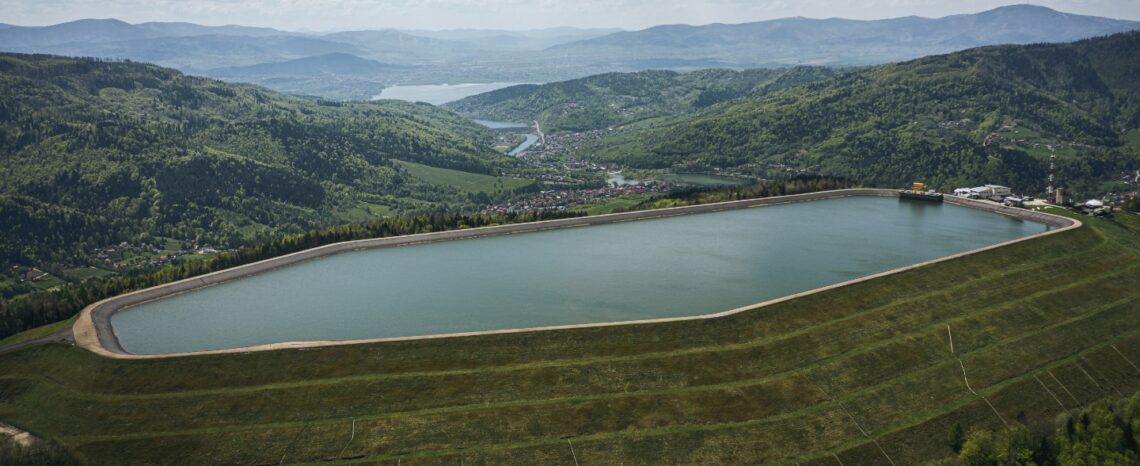

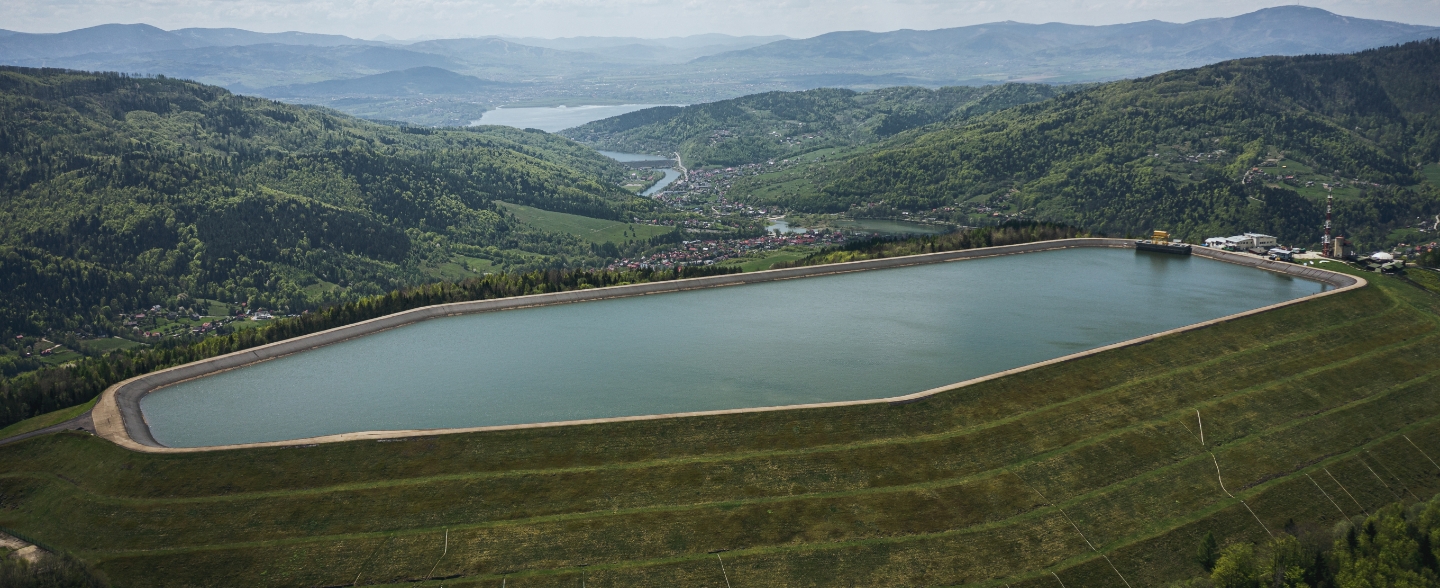
For PGE as Poland’s leader in hydropower generation, a responsible approach to the use of hydropower and pumped storage plants is of particular importance. As regards PGE Energia Odnawialna, the key issues include surface and underground water intake and discharged wastewater, which is subject to constant testing and analysis for compliance with the requirements of water permits. Wastewater treatment facilities are operated at individual sites, where operational inspections of separators are performed by specialist companies and, as required, waste is cleaned, collected and disposed of, and adsorption filters are replaced. In its operations, the company takes into account the risk of harmful substances entering the environment through contamination of water reservoirs as a result of failures of the hydro-set equipment. PGE Energia Odnawialna takes remedial measures which consist in continuous monitoring of equipment operation by power plant operators, regular inspections and carrying out repair, operation and modernisation works. Municipal sewage is discharged in accordance with contracts with municipal companies.
